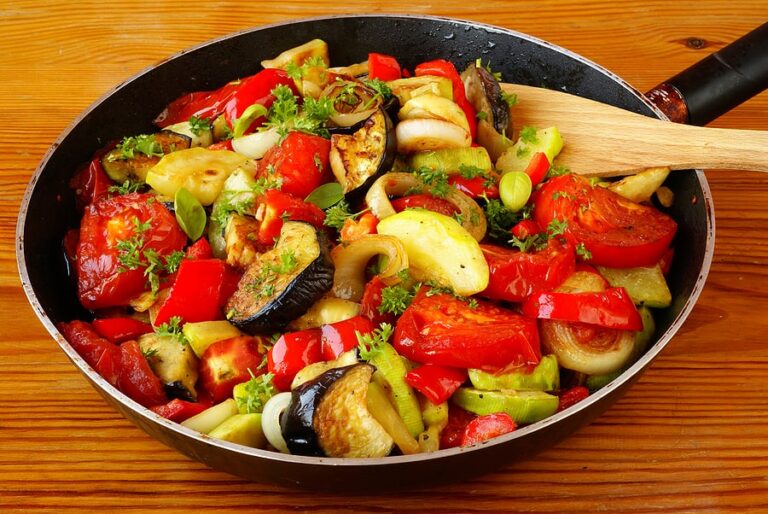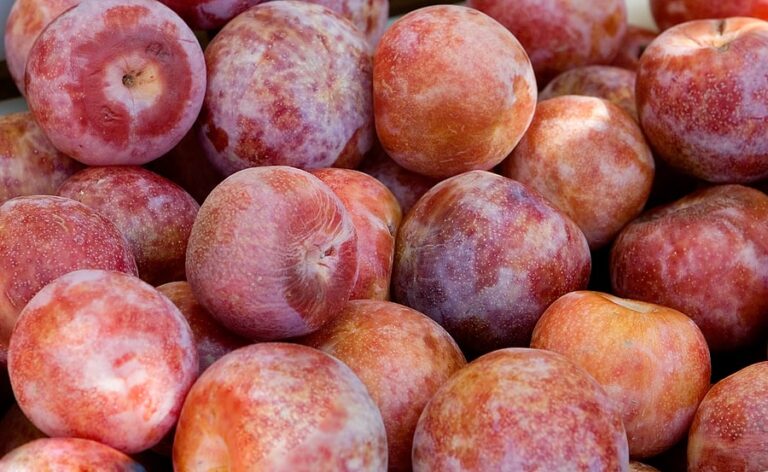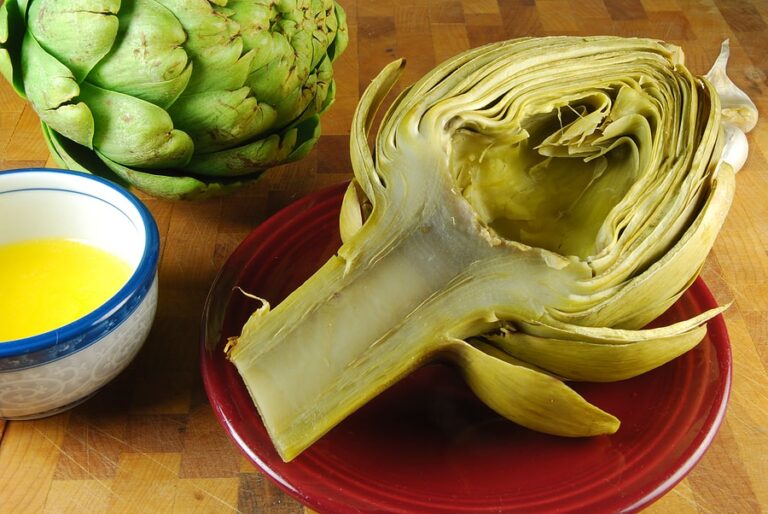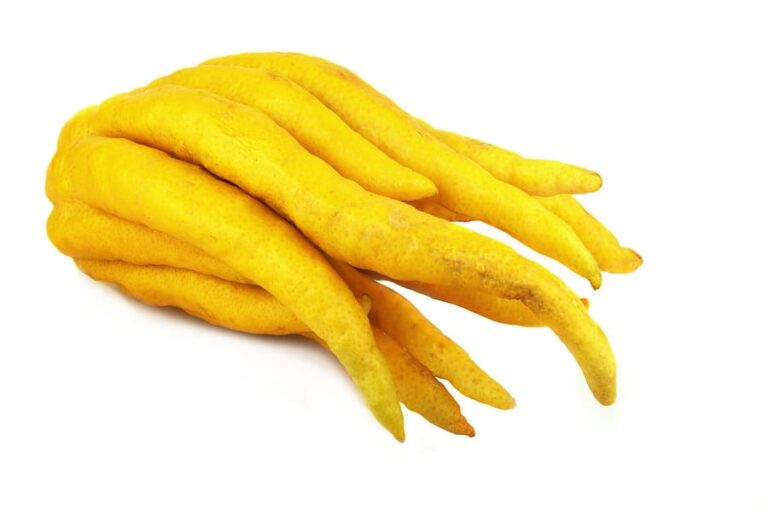Tasty Ways to Cook and Serve Rhubarb
Rhubarb is sharp and pungent with a fresh spring taste.
Fresh rhubarb sauce and pie season starts in early spring and runs nearly to the first day of summer.
Often thought of as a fruit, rhubarb is a vegetable. In some regions, rhubarb is so much thought of as a dessert fruit that it is also called pieplant.
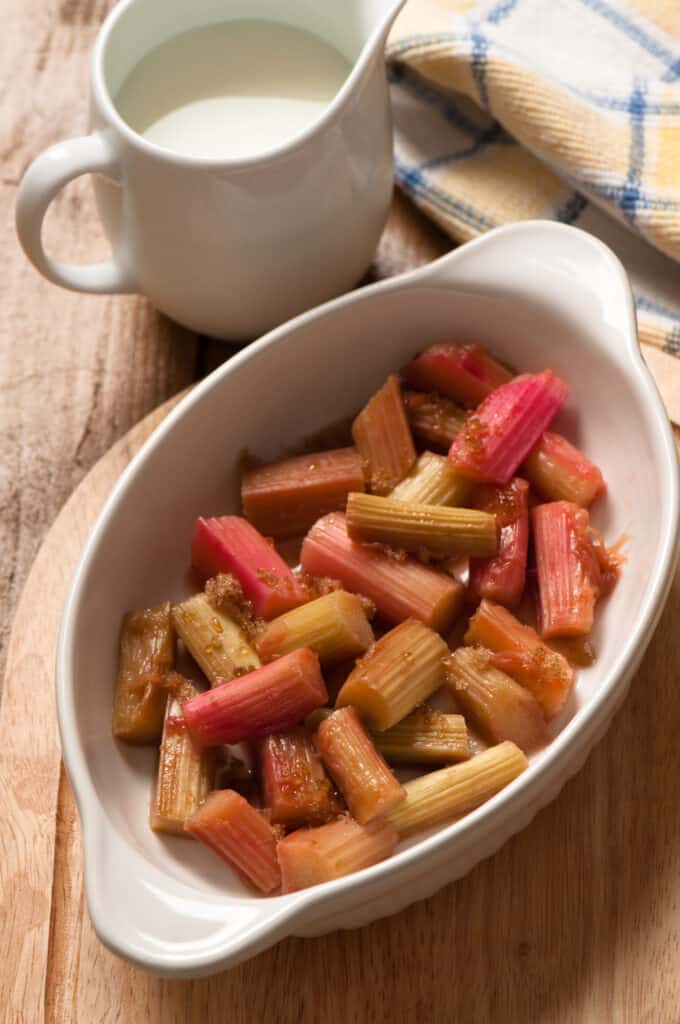
Rhubarb is too tart to be enjoyed raw. To take rhubarb to pie heights you’ll need to add sugar or another sweetener. Then you can enjoy rhubarb’s sweet-sour fruity taste that hints of apricot, strawberry, and lemon all rolled into one.
In America, rhubarb and strawberries are often paired, in Britain rhubarb and ginger.
The peak season for rhubarb fresh out of the garden—or field–is spring through summer. It’s most flavorful in the spring. The season for hothouse-grown rhubarb is mid-winter through early spring.
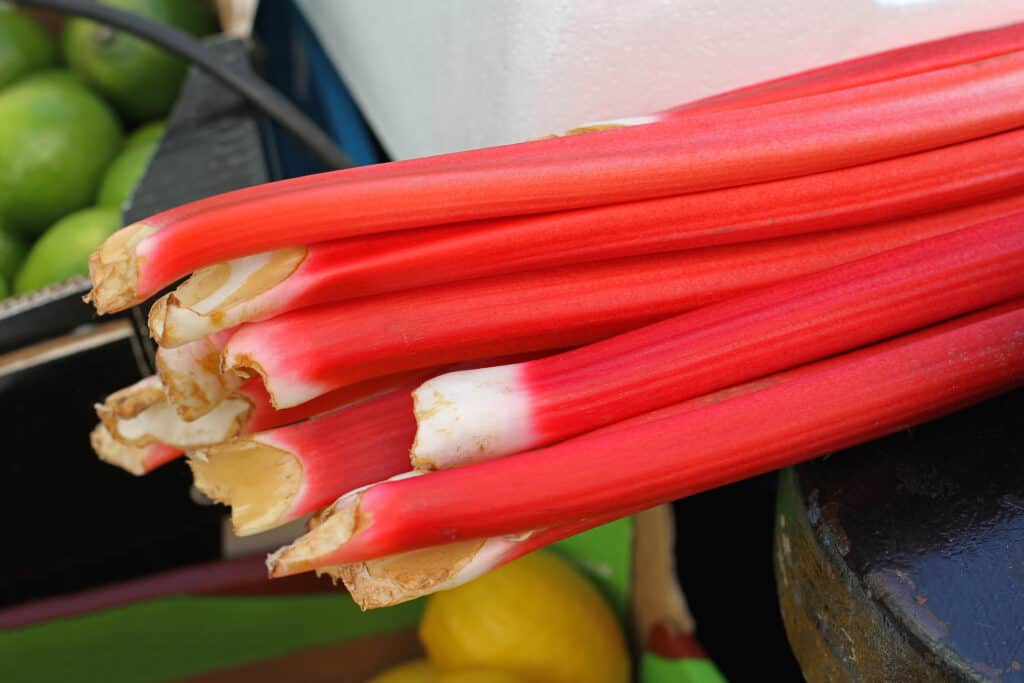
Favorite rhubarb recipes
Types of rhubarb
- There are at least 20 varieties of rhubarb, but essentially only two types: field or garden-grown and hothouse grown.
- Field-grown rhubarb–also called cherry rhubarb–has deep red stalks and green leaves. It is juicy and acidic.
- Hothouse rhubarb–also called strawberry rhubarb—has pink to pale red stalks and yellowish-green leaves. It also has smooth flesh and a delicate texture. Hothouse rhubarb is less acidic and milder tasting than field-grown rhubarb and requires less sweetener when cooked.
Kitchen Helpers from Amazon:
- Oster Vegetable Steamer
- Chef’s Knives Set of 6
- EZ Off Jar Opener for Weak Hands
- Pepper Core Remover Stainless Steel
- Kitchen Utensils – Set of 35
How to choose rhubarb
- Select rhubarb that is firm and crisp with stalks of the brightest colors. If the leaves are attached, they should be fresh-looking without blemish.
- Avoid rhubarb stalks that are bruised, blemished or pithy.
How to store rhubarb
- Keep rhubarb tightly wrapped in a plastic bag and refrigerated in a plastic bag for up to 5 days. Do not wash rhubarb until you are ready to cook.
- You can freeze rhubarb but you must cut it into pieces and stew it first.
- Preserve rhubarb by cooking it and then placing it in a warm sterilized jar, or fill the jar with alternating layers of raw rhubarb pieces and sugar, seal the jar, then sterilize the jar in boiling water.
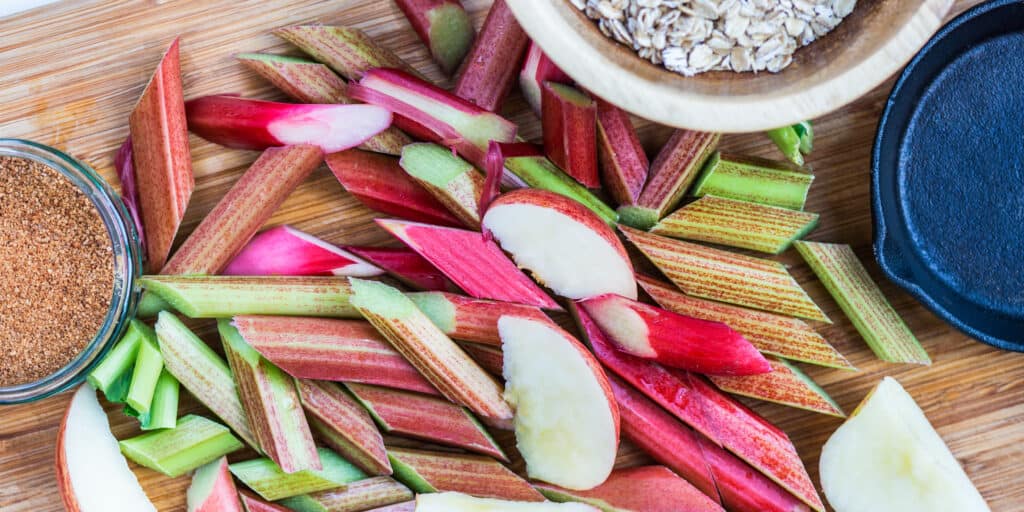
How to prep rhubarb for cooking
- Trim off the ends, wash the stalks, and cut them into ¾ inch (19 mm) pieces.
- Cut rhubarb slices on the diagonal against the grain of the stalk. If the rhubarb is stringy, pare the stalks and pull off the strings. Hothouse rhubarb should not need peeling.
- Cut out and discard any green tissue.
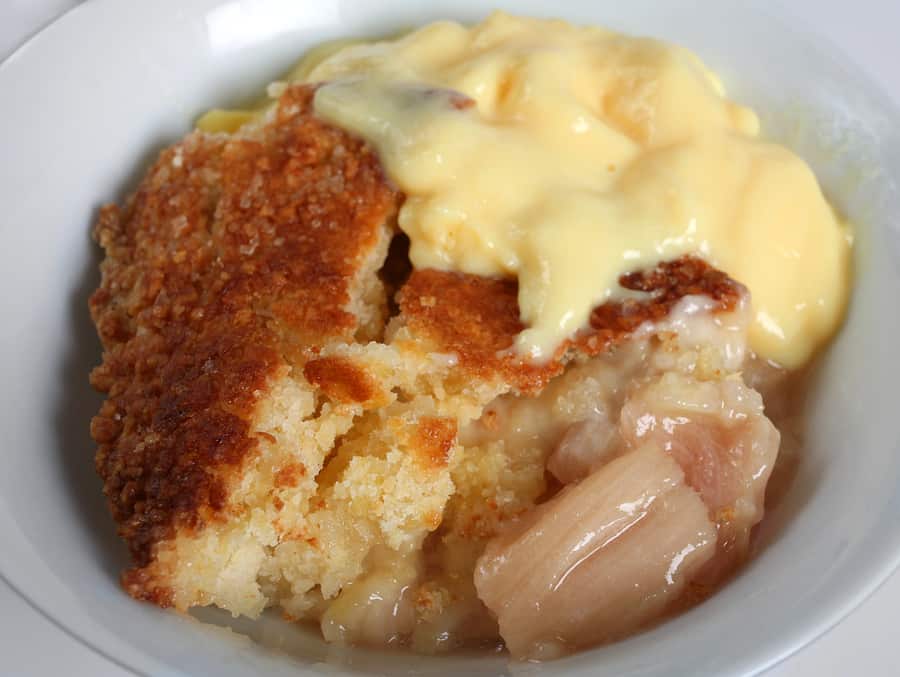
Rhubarb serving suggestions
- Rhubarb can be stewed or baked. It is used to make sauces, jams, and desserts such as pies, cakes, and muffins. It is commonly cooked and made into compote, marmalade, or marinades and it is also incorporated into sorbets, ice cream, and punches.
- Rhubarb’s thick, celery-like stalks are often sliced or chopped and cooked to accompany both savory dishes—meats and fish—and desserts. Rhubarb is interchangeable with cranberries in most recipes.
- Plain stewed rhubarb without sweeteners will be unpleasantly tart and strong tasting. To overcome the tartness, poach rhubarb in light sugar syrup or stew it with other fruits.
- You can cook rhubarb in a small amount of water over moderate heat for about 20 minutes or until soft. You will not need to purée it. Cook rhubarb with sugar slowly.
- Use stewed rhubarb for fruit pies. Put stewed rhubarb sauce on top of cheesecake or vanilla pudding or serve it on hot buttered cinnamon toast.
- To prepare a rhubarb sauce for hotcakes, waffles, crepes, and ice cream, chop the thick, fleshy leafstalks into 1-2 inch (25-50 mm) pieces, then boil in water, cover and add sugar to taste.
- Rhubarb can be used in recipes that call for apples. Rhubarb blends well with strawberries and apples. For a richer flavor, you can add a few raisins.
- Fold sweetened, cooked diced rhubarb into yogurt. Add finely chopped rhubarb to any nut bread recipe. Use baked or stewed rhubarb as a topping for a cooked breakfast cereal.
- Sweetened rhubarb juice makes a refreshing cold drink.
- The flavor of rhubarb can be improved by adding orange juice, marmalade, or cinnamon.
- Avoid using aluminum pans when cooking rhubarb so that it does not discolor.
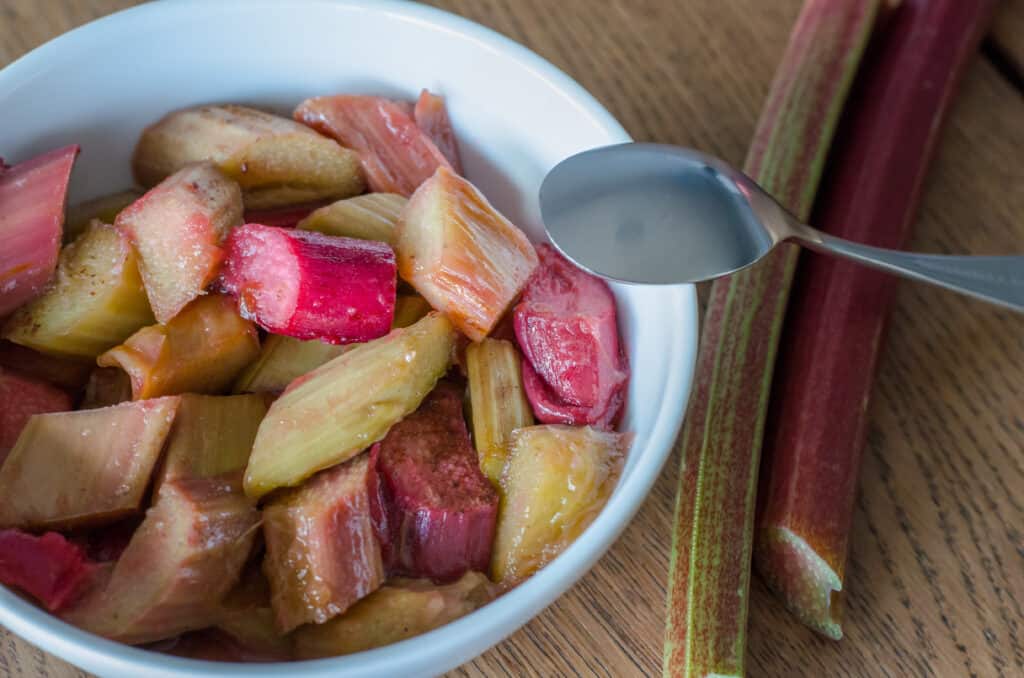
How to stew rhubarb
- Trim the rhubarb and cut stalks into 1/4-inch pieces.
- Put the rhubarb, 2/3 cups sugar, and 2 tablespoons of water in a medium saucepan over medium-low heat.
- Simmer gently, stirring occasionally, until the sugar is dissolved and the rhubarb is almost tender, about 8 minutes.
- Use a slotted spoon to remove the rhubarb from the liquid, and transfer it to a medium bowl.
- Raise heat to medium, and continue simmering liquid until thickened and reduced to 1/2 cup, about 10 minutes.
- Transfer the reduced liquid to a small bowl to cool.
- Add the cooled and thickened liquid to the reserved cooked rhubarb, and stir to combine.
How to braise-bake rhubarb
- Prepare the rhubarb then chop stalks into 1 to 2-inch pieces and place in an oven-proof dish.
- Add 1 cup of sugar and 2 tablespoons of water and combine with a spatula; be sure the rhubarb is well coated. (Alternatively, you can coat the rhubarb with honey, juice from an orange, 1/4 teaspoon vanilla, and grated ginger.)
- Refrigerate the coated rhubarb in the covered baking dish for at least 2 hours.
- Preheat oven to 350 degrees F.
- Place the rhubarb in the oven and bake until the rhubarb can be easily pierced with a fork, about 20 minutes.
- Remove from oven and let cool for 5 to 10 minutes before serving.
- Serve warm with vanilla ice cream, yogurt, or pudding.
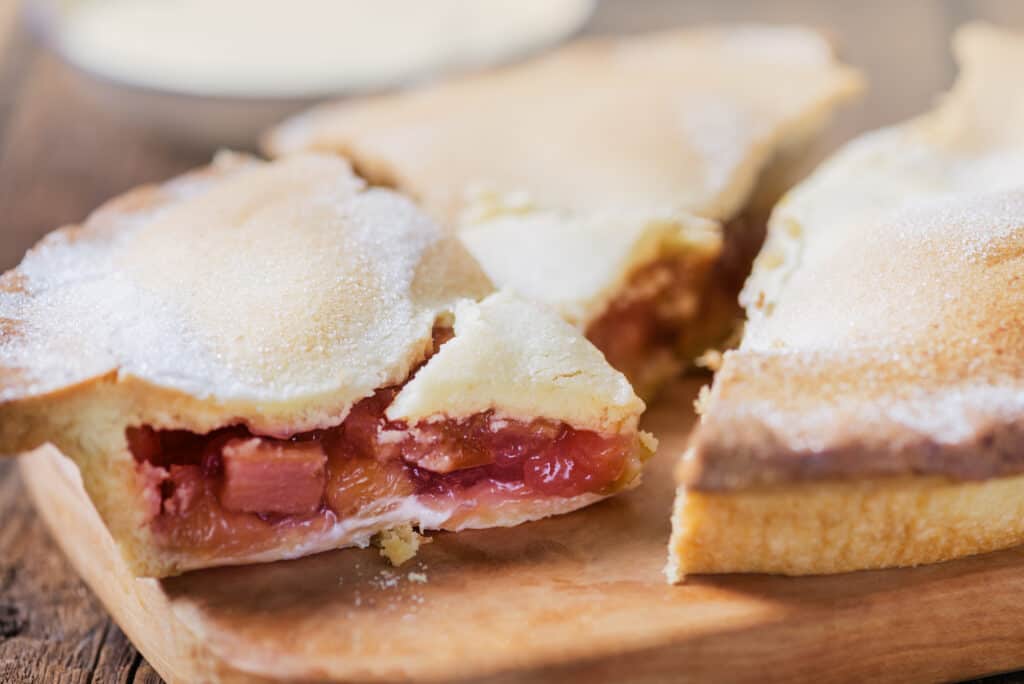
How to make rhubarb pie
- Prepare the rhubarb then cut into 1-inch pieces; prepare 6 cups of chopped rhubarb.
- Preheat the oven to 375 degrees F.
- Prepare the pie filling by combining 1/3 cup flour, 3/4 cup sugar, and a bit of cinnamon.
- Use a spatula to combine the filling and rhubarb so that the rhubarb is well-coated with the filling.
- Line a 9-inch pie plate with pie pastry dough. Trim the pastry around the edge of the plate if it hangs over.
- Use a spatula to transfer the rhubarb and pie filling into the pie plate and smooth it even. Top it with more pie pastry. Seal the 2 crusts together by pressing down on the entire edge of the pastry with a fork, merging the two crusts.
- Cover the pie with aluminum foil and place it on the center rack and bake for 25 minutes. The foil will keep the crust around the edges from burning.
- Remove the aluminum foil and bake another 25 to 30 minutes until the crust is golden brown.
Rhubarb flavor partners
- Rhubarb has a flavor affinity for blackberries, brown sugar, duck, ginger, goose, honey, maple syrup, oily fish, raspberries, and strawberries.
- Season rhubarb with lemon, cinnamon, and ginger.
Rhubarb nutrition
- Rhubarb contains vitamins A and C and is rich in potassium and calcium.
- Rhubarb is rarely consumed on its own because of its high acidity—sugar is often added increasing caloric content.
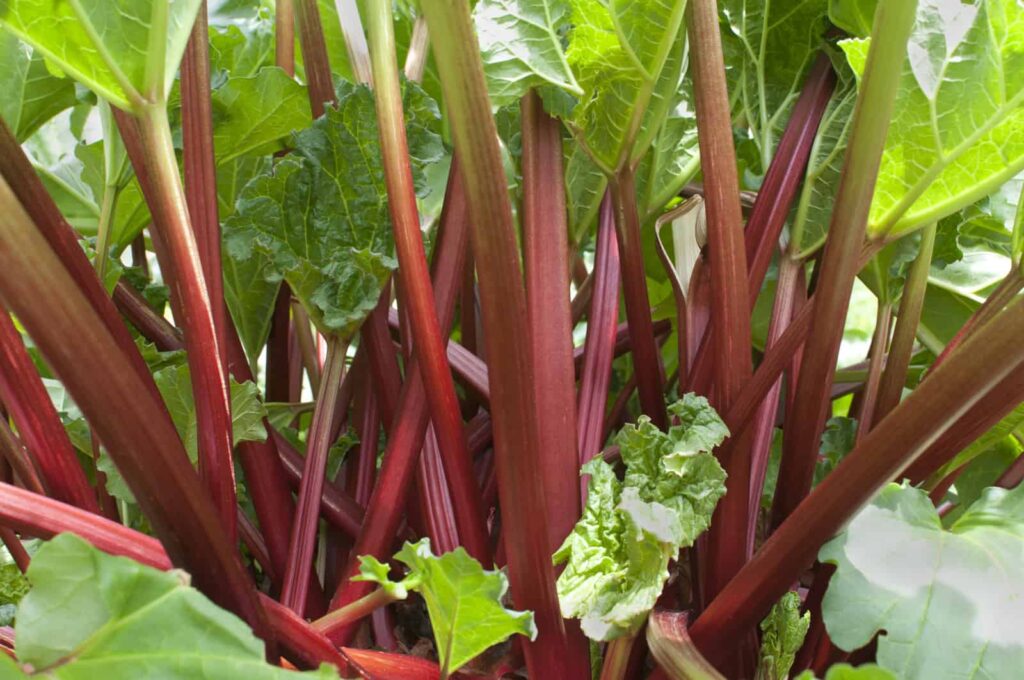
Get to know rhubarb
- Rhubarb is a hardy, cool-season perennial plant with thick, red, fleshy stalks topped by wide, crinkled, green leaves. Rhubarb stalks can grow to 3 feet tall (90 cm) and between 1 and 3 inches (2.5-7.5 cm) thick. Rhubarb leaves are inedible. They contain oxalic acid and can be toxic.
- Rhubarb is thought to have originated in Mongolia or southern Siberia. It flourishes in cool to cold regions and grows from rhizomes or crowns which can survive in the frozen ground during the winter. Rhubarb needs winter chill for its thick stems and red color.
- The first record of rhubarb appeared in a Chinese herbal dating from 200 B.C. The first mention of rhubarb as a food plant came in tenth-century French recipes for tarts and pies. The varieties known today were popularized in the nineteenth century.
- The word rhubarb comes from the Latin word reubarbarum—meaning root of the barbarians—a designation for a root or plant that is unfamiliar or foreign.
- In 1947, a United States court decision deemed rhubarb a fruit even though it is botanically a vegetable. The court ruled that since rhubarb is most often used as a fruit in the kitchen it should be considered one legally. It may sound like a silly decision but at the time it meant a 15 percent lower duty tax on imported rhubarb.
The botanical name for rhubarb is Rheum rhabarbarum.
Rhubarb articles at Harvest to Table:
How to Harvest and Store Rhubarb
Tasty Ways to Cook and Serve Rhubarb
Articles of interest:
Best Herbs for Container Growing
Garden Planning Books at Amazon:
- Vegetable Garden Almanac & Planner
- Kitchen Garden Grower’s Guide Vegetable Encyclopedia
- Vegetable Garden Grower’s Guide
- Tomato Grower’s Answer Book
More kitchen tips:
Bring your harvest to the table. Kitchen prep tips and easy recipes for the vegetables you grow. Click below for vegetable prep and recipes you can use now.
- Almonds
- Apples
- Apricot
- Aprium
- Artichoke
- Arugula
- Asparagus
- Avocado
- Bamboo Shoots
- Banana
- Basil
- Beans, Dried
- Beans. Long
- Beans, Shell
- Beans, Snap
- Beets
- Bitter Melon
- Blackberry
- Bok Choy
- Broccoli
- Broccoli Raab
- Brussels Sprouts
- Cabbage
- Cardoon
- Carrots
- Cauliflower
- Celeriac
- Celery
- Chard
- Chayote Squash
- Cherimoya
- Cherries
- Chestnut
- Chickpea
- Chinese Cabbage
- Chives
- Cilantro
- Citron
- Clementine
- Collards
- Coriander
- Corn, Sweet
- Corn, Baby
- Corn Salad, Mache
- Cranberry
- Cress
- Cucumber
- Daikon
- Dandelion
- Dill
- Eggplant
- Endive, Belgian
- Endive and Escarole
- Fava Beans
- Fig
- Florence Fennel
- Garlic
- Ginger
- Grapefruit
- Grapes
- Guava
- Horseradish
- Jerusalem Artichoke
- Jicama
- Jujube
- Kale
- Kiwifruit
- Kohlrabi
- Kumquat
- Leeks
- Lemongrass
- Lemons
- Lettuce
- Lime
- Mache (Corn Salad)
- Mandarin Orange
- Mango
- Maple Syrup
- Marjoram
- Melons
- Michihili
- Mint
- Mizuna
- Mushrooms
- Mushrooms, Cremini
- Mustard Greens
- Napa Cabbage
- Nectarine
- Okra
- Olives
- Olive oil
- Onions
- Oranges
- Oregano
- Parsley
- Parsley Root
- Parsnips
- Passion Fruit
- Pawpaw
- Peaches
- Pears
- Peas, Garden Snap
- Peas, Snow
- Pei Tsai
- Peppers, Chili
- Peppers, Sweet
- Persimmon
- Pineapple
- Pineapple Guava
- Plantain
- Plums
- Pluots
- Pomegranate
- Potatoes
- Prickly Pear
- Pumpkin
- Quince
- Radicchio
- Radishes
- Raspberries
- Rosemary
- Rhubarb
- Rutabaga
- Sage
- Salsify
- Sauerkraut
- Savory
- Shallots
- Sorrel
- Spinach
- Squash, Summer
- Squash, Winter
- Strawberries
- Sunchokes
- Sunflower
- Sweet Potato
- Swiss Chard
- Tangerine
- Taro
- Tarragon
- Thyme
- Tomatillo
- Tomato
- Turnip
- Turnip Greens
- Yams


